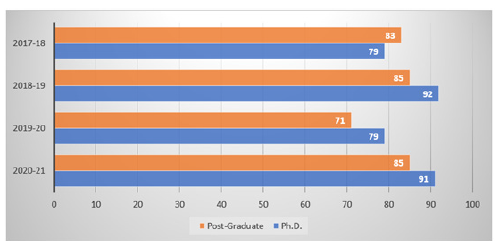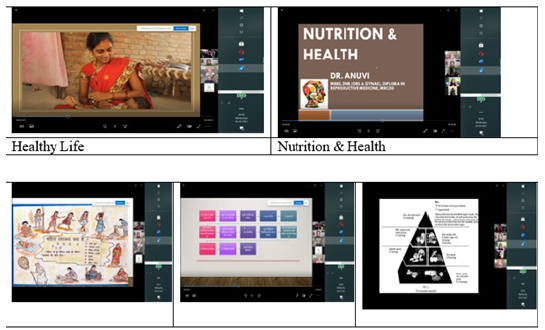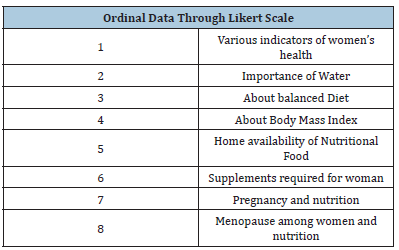- Submissions

Full Text
Investigations in Gynecology Research & Womens Health
Women in Medical Education & Women’s Health in India
Seema Singh*
Professor of Economics, Delhi Technological University, India
*Corresponding author: Seema Singh, Professor of Economics, Delhi Technological University, Delhi, India
Submission:May 08, 2023;Published: May 25, 2023

ISSN: 2577-2015 Volume4 Issue4
Introduction
Women comprise almost half of the world’s population but unfortunately, they face more adversaries than their counterparts. Gender inequality is a challenge in both richer as well as poorer countries [1]. Women receive only 10 per cent of the world’s income, and own merely 1% of the world’s property [2]. Even COVID-19 has affected more adversely to women [3]. Global extreme poverty has risen in 2020 as the disruption of the COVID-19 pandemic [4] and women represent a majority of such poor in most regions of the world. The division between reproduction and production is so distinct in a patriarchal society that women do not get enough chances to participate in the production process as they have to perform a lot of caregiving and unpaid work. They do not get recognition and control over income even if they participate. Though the situation has improved, it is far from satisfactory in India, which can be seen in the skewed sex-ratio against women as it is one of the crucial indicators for discussing the status of women.
Women face discrimination in almost all aspects as education, employment, decisionmaking, and legal issues but the most significant is health. Women in their life cycle, biologically experience more changes and give birth to a new life. So, an unhealthy mother is bad not only for the present generation but for the future also. In this background, the discussion has been divided into four sections. The second section discusses the situation of women in medical education. The health situation of women has been discussed in the third section. The fourth section discusses the experience of online training programs for girls and women from the lower segment of society. The last section concludes the discussion and provides suggestions.
Women in Medical Education in India
Traditionally, medical education has been associated with women and engineering education with males. Though women’s participation in engineering has significantly increased in recent years [5] medical education has remained a priority which can be seen from favorable gender parity for them from (Table 1). More so, there is a very high participation of women at higher gynaecology education, PhD ad post-Graduate which is clear from the Figure 1. It shows that more women doctors are doing research in the area. Studies have shown that there are gender differences in terms of medication use [6]. Women’s and men’s bodies behave differently for some medicines [7]. So, more women at the PG and PHD levels of Gynaecology, it can be inferred that they would be more sensitive towards women’s medicine.
Table 1: Number of female students per 100 male students enrolled for Bachelor of Medicine and Bachelor of Surgery (MBBS).

Source: AISHE, 2020-21, pp. 51.
Figure 1:Share of women in Ph.D. and post-graduation of gynecology. Source: Made by author from Table of AISHE for these years.

Health Situation of Women in India
The discussion on the health situation of women in India has been done on the basis of National Family Health Survey [8] 4 & 5 data (Table 2) which has been divided into four sections as Women’s Health Status, Health Issues which need more research, awareness and women who have got benefit from the existing programs of the government to provide free medication. Though the share of women covered under all indicators of Table 2 shows positive results but even now, miles to go. The World Health Organization at the 67th Commission on Status of Women reiterated its commitment to improving the health outcomes of women through technology and digital innovation for gender equality and gender empowerment [9]. So, there is huge scope for enhancing e-medicine facilities not only for government consultation but for informing prospective beneficiaries.
Table 2:Health situation of women in India.

Source: National Family Health Survey (NFHS-5) 2022.
Experience of online training programme for girl and women from the lower segment of society
I as a Principal Investigator and my team did a project on, “Enhancing Employability Skills for Empowerment of Girls and Young Women” funded by Graduate Women International Geneva during 2019-21. As women’s health is a key issue for women’s empowerment, besides sessions on yoga for women by Ms Akanksha Singh at Patna on 27.12.2019 and Mr P.K. Mehrotra at Delhi on 14.3.2020, there was an online mentoring session on 23.1.2021 by two practicing doctors also. These two doctors, Dr Pushpendra Singh, Practicing Doctor and Entrepreneur, New Delhi and Dr Anvi Department of Health, Jharkhand Government, Ranchi discussed the main physical indicators of health, a balanced diet which can be taken by even poor women and the medicinal value of our food items presents in a common kitchen (Figure 2).
Figure 2:Some of the screenshots of the presentations made by both doctors during the mentoring programme.

Generally, women take care of everyone in the family, but they do not take care of their own meals. Even others as husbands or other female family members do not ask them to eat. Dark circles around the eye, back pain or bad teeth are some of the signs of malnutrition. Other common diseases are diabetes, hypertension, anemia etc. In the case of many women, the built may be fat but internally, there are chances of being malnutrition. Women normally need 1800-2000 calories/day. Pregnant women and lactating mothers need more calories. So, they need to have at least three meals i.e., Breakfast, Lunch and Dinner. Doctors also clarified some of the myths as Ghee (Clarified Butter) is better than Dalda (processed fat). One should drink a lot of water. Taking sufficient sleep and rest is very crucial for women as household work is for twenty-four hours. Participants were also suggested to find some time for themselves. They need to exercise daily, which even may be a walk for 15-20 minutes. They were also informed about calculating Body-Mass Index (BMI) which is calculated as the body mass divided by the square of the body height and is expressed in units of kg/m². Anyone whose BMI is <18.5 is underweight and a BMI of 25 or more will be overweight or obese. Some of the questions which were asked by the participants are given in Table 3. Participants were asked to fill in a questionnaire (Table 4) before and after the session and the result was quite encouraging.
Table 3:Some of the questions raised by participants in the online program.

Table 4:Awareness about health issues of the online mentoring program.

Conclusion and Suggestions
Health is one of the prime inputs for women’s empowerment and healthcare at market price is beyond the reach of a large women’s population. Governments as a welfare state are providing many health benefits of which the majority of women may not be aware. The World Health Organisation at the 67th Commission on Status of Women has reiterated its commitment to improving the health outcomes of women through technology and digital innovation for gender equality and gender empowerment [9]. Programmes of e-interaction between doctors and women from the lower segment need to be designed and implemented as has been discussed in the paper. A larger share of women at the PhD and the Post Graduate level of Gynaecology puts the responsibility on the doctors also to realize specific health issues of women and work as well as raise their voice among the fraternity [10,11].
References
- Duflo E (2012) Women empowerment and economic development. Journal of Economic Literature 50(4): 1051-1079.
- Glenn K (2015) The zombie statistic about women’s share of income and property. Washington, USA.
- Madgavkar A, Olivia W, Mekala K, Deepa M, Xavier A (2020) COVID-19 and gender equality: Countering the regressive effects, Mckinsay & Company, Chicago, USA.
- World Bank (2021) 2021 Year in Review in 11 Charts: The Inequality Pandemic. International Bank for Reconstruction and Development, Washington, USA.
- AISHE (2022) All India Survey of Higher Education-2020-21, Department of Higher Education, Ministry of Education, Government of India, New Delhi, India.
- Valentina O, Sara M, Guarino I, Francesca G, Trama U, et al. (2020) Gender differences in medication use: A drug utilization study based on real world data. International Journal of Environmental Research and Public Wealth 17(11): 3926.
- Huey N (2018) Treating men and women differently: Sex differences in the basis of disease. The Graduate School of Arts and Science, Harvard University, USA.
- NFHS (2022) National Family Health Survey-5. Government of India, New Delhi, India.
- WHO (2023) WHO’s side event on improving health outcomes for women and girls through digital innovation, Technology and Education, USA.
- GoI, All India Survey of higher education for several years, Ministry of Education, Government of India, Delhi, India.
- Seema S, Parinita S, Antra S, Itishree C (2021) Enhancing employability skills for empowerment of girls and young women. BRPID Project, Graduate Women International, Switzerland, Vidya Kutir Publications, New Delhi, India.
© 2022 Seema Singh. This is an open access article distributed under the terms of the Creative Commons Attribution License , which permits unrestricted use, distribution, and build upon your work non-commercially.
 a Creative Commons Attribution 4.0 International License. Based on a work at www.crimsonpublishers.com.
Best viewed in
a Creative Commons Attribution 4.0 International License. Based on a work at www.crimsonpublishers.com.
Best viewed in 







.jpg)






























 Editorial Board Registrations
Editorial Board Registrations Submit your Article
Submit your Article Refer a Friend
Refer a Friend Advertise With Us
Advertise With Us
.jpg)






.jpg)














.bmp)
.jpg)
.png)
.jpg)










.jpg)






.png)

.png)



.png)






